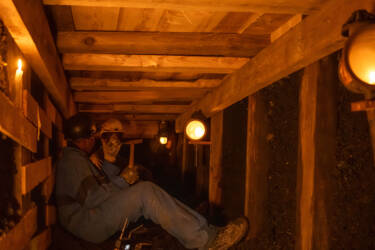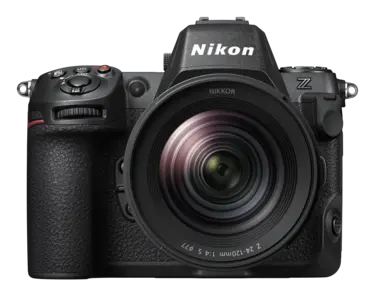Dystopian sci-fi short wins Nikon Film Festival

Monsieur Pioche awarded Grand Prix from more than 2,000 entries
The Nikon Film Festival, organised each year by Nikon France, celebrates the creativity of the moving image across a huge variety of styles, all based on the same theme. Aside from the theme, there is only one rule: all films have to be no more than two minutes and 20 seconds. There’s no fee to enter, so the Nikon Film Festival offers an opportunity to everyone with a vision and a camera to take part.
This year’s theme was ‘a human superpower’, which led to more than 2,000 entries and ended in a gala showcase event at the Grand Rex cinema in Paris, where Monsieur Pioche, a film by Maxime Lorgerie, was named the overall winner.
The calibre and number of submissions was a huge testament to the creativity and passion of emerging filmmakers. “It was a record number of entries this year, with 2,137 films and 146 series submitted – and the quality continues to rise,” says Alexandre Dino of Nikon France. “Each year, the quality of the submissions continues to rise, reflecting the high standards and innovative spirit of a new generation of talent. At Nikon, we are deeply committed to supporting and showcasing these visionary storytellers, and we look forward to celebrating their achievements and providing funding opportunities or production support to help filmmakers with this inspiring event. The evening at the Grand Rex (recently voted the most beautiful cinema in the world) has become a key event for all professionals and film lovers across France, and we are extremely proud to have created such an important moment for the short film industry.”
Nikon magazine sat down with winner Maxime Lorgerie to talk about his film, the inspiration behind it and his process, from idea to screen.
What’s in our kitbag?

How do you think the film fits in with this year’s festival theme?
I wanted to approach the theme of a human superpower in as realistic and down-to-earth way as possible. I wanted to show that a superpower, which can be seen as a gift, can also become a curse and a source of exploitation. In Monsieur Pioche, the children selected by the Mubik company to extract ‘noxium’ each have this superpower that enables them to resist the radiation of this resource. This ‘gift’, which they have developed by living in close proximity to the stone, actually becomes their curse without them realising it. They almost think they’re privileged, because it’s a job that pays well, but this blinds them to the real danger of noxium mining.
Where did the idea for the film come from?
It came to me after seeing a viral video showing the collapse, due to climate change, of a mountain in Congo, revealing large quantities of copper that the local population would be able to mine. The thing that struck me was the shrieks of joy from the people at the scene, all happy to discover these new resources. It was the contrast between the happiness of these people and the working conditions they would experience to extract these minerals, risking their lives for very little pay, that inspired this scenario and the ending of my film: a child who, despite all the horrors he has seen in this mine, smiles at his salary.

How did you develop the idea into a final film?
I built my script around this ending, but I was immediately faced with a problem: how could I convey all these elements to the audience in less than 2 min 20 seconds? Children who had developed a superpower, symbolised by the orange gleam in their eyes, enabling them to withstand the radiation from ‘noxium’, a most precious resource. So I came up with the idea of using a cartoon character, Monsieur Pioche, to explain all the essential elements of the scenario to the children, but also the viewer. I contacted my friends at Étincelle Post-Production, in Toulouse, who took care of all the post-production, VFX and colour grading for my film. We worked on the concept of the cartoon and Monsieur Pioche. Maxime Rey-Camet drew him, with the help of Florian Pineau, and that brought him to life. The feel of the cartoon was inspired by propaganda of the 1930s and became the element around which the whole film would be built.
How did the casting go?
I contacted Brigitte Lecordier, whom I met on a previous shoot, to talk to her about the project, and she immediately agreed to lend her voice to Monsieur Pioche. As for the kids in the film, a few years ago I met a great person and actor called Thierno Ba. One day, when I was looking for a child actor for a film I was making, Thierno introduced me to his son: Mohammed Simon Ba. I loved working with him, and we often filmed together after that. I was always impressed by his ability to naturally convey so much emotion without ever using words, so it was a no-brainer for me to offer him the lead role this time. For the other two characters, I met Djibril, Mohammed’s older brother, and Samba, one of Mohammed’s friends and we all connected immediately.

You and your father built the set for the mine…
Ever since I started making films, I’ve been lucky enough to be have exceptional parents who have always supported and helped me with my wildest ideas, fully trusting me every time. My father has always been a tinkerer at heart so, when I asked him to help me build a mine, he immediately helped me make it possible and realistic. The two of us built it in just a few days, using all the salvaged elements from his old building sites (see the video below for a behind the scenes). For the rest of the sets, set designer François Ferchaud transformed an old swimming pool tent into a makeshift ‘laboratory’. Alongside this, I worked with costume designer Anaïs Levray to develop the film's costumes, colours and visual style. Since I've been in this business, I’ve always been lucky enough to be accompanied by extraordinary people, whether on the technical team or with the actors and actresses I work with. It’s the sum of all these talents that made Monsieur Pioche possible.
How long did it take you to shoot the film?
It was shot in one day. A morning to do the scenes in the tent, the afternoon for the scenes in the mine, and in the evening, after dark, for the final scene on location. The entire film was shot in a warehouse behind my parents’ home, which my father uses to store all his construction equipment. For the animation, I used Microsoft’s little paper-clip character as a reference. I wanted the simplest possible design: a little pickaxe with eyes.

The lighting conditions were very special. How did you go about it?
I wanted the most realistic lighting possible for this film. I had to film characters in a mine lit only by candles, so I wanted this to be my only source of lighting, to be as realistic and seamless as possible. We’re lucky to have cameras today that can film in very low light conditions, so it was worth the risk.
What did you want viewers to feel after watching your film?
I’d say the feeling of spending 2 min 20 seconds in another universe, at once so distant yet so close to our own. That’s why I love science fiction. And, for me, that’s what it’s all about: looking at the problems of our society by transporting viewers into another universe, where it’s sometimes easier to see the absurdities of our world.
Watch Monsieur Pioche and a selection of the entries from this year’s Nikon Film Festival click here or watch the behind the scenes below.
How to win at the Nikon Film Festival
Winning at the Nikon Film Festival can be a springboard to a successful career as a filmmaker, so we asked jury member and director Jacques Ballard for his tips on how to catch the judges’ eye with your entry.
“The first and last shots of a film are sacred,” says Jacques. “The opening shot should invite us straight into what matters narratively, give us a point of view on what we’re about to experience and plunge us into a remarkable perspective. It’s as important as a first meeting in real life.”
As for the ending, Jacques says the viewer needs to come away with an emotional response that lives in the memory. “A self-centred film will probably leave me with little memory,” he says. “I can remember a film that makes me laugh, cry, think or surprises me for a very long time. That’s very difficult to achieve because it depends on the entire team, and also a bit on luck as to whether you manage to capture it or not.
“A weak script, uninspired actors, image and sound that don’t match the point of view or the moment, editing lacking sensitivity, poor sets… all these can unfortunately put a film at risk. But making a film is quite incredible. If, on top of that, it’s successful, it’s magic!”
So get storyboarding and keep an eye out for the launch of the next Nikon Film Festival later this year.
More in Inspiration
More in software

Unlock greater creativity









